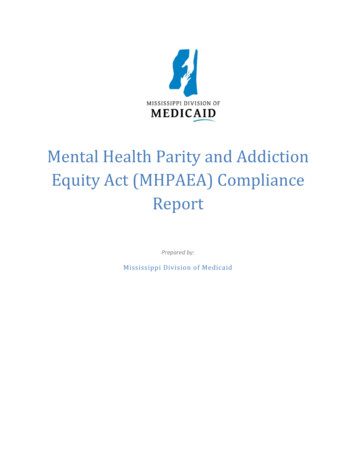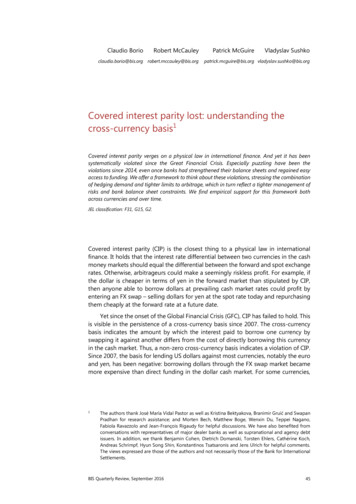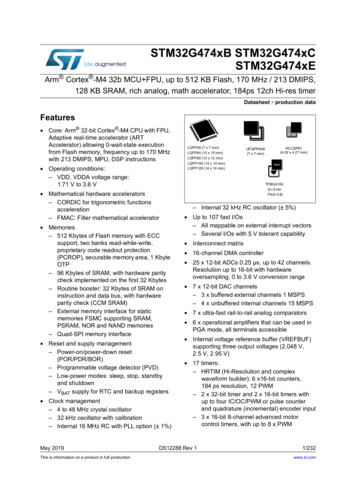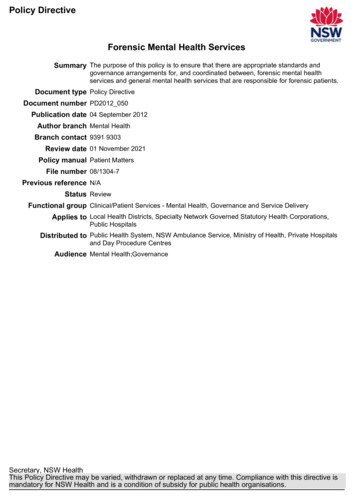
Transcription
Mental Health Parity and AddictionEquity Act (MHPAEA) ComplianceReportPrepared by:Mississippi Division of Medicaid
Mississippi Division of MedicaidMHPAEA Compliance ReportTable of ContentsIntroduction . 2Process Overview . 2Benefit Packages and MississippiCAN . 2Defining Mental Health and Substance Use Disorder Benefits . 4Benefit Classification Types . 4Financial Requirements, Quantitative Limitations, and Aggregate Lifetime/Annual Dollar Limits . 5Non-Quantitative Treatment Limits. 6Medical Necessity . 7Prior Authorization. 8Concurrent Review. 8Pharmacy Services . 8Summary and Findings . 8Appendix A: CCO Handbook Links. 10Appendix B: Parity Analyses from Coordinated Care Organizations . 111
Mississippi Division of MedicaidMHPAEA Compliance ReportIntroductionThe Mississippi Medicaid Program and Children’s Health Insurance Program (CHIP) are operated by theDivision of Medicaid (DOM). DOM covers about 30 percent of its beneficiaries through a fee-for-servicemodel, managing delivery and administration of services. DOM also oversees coverage for beneficiariesdelivered through Coordinated Care Organizations (CCOs), which includes about 70 percent of allMedicaid beneficiaries in Mississippi, including 100 percent of CHIP recipients.On March 30, 2016, the Centers for Medicare and Medicaid Services (CMS) issued regulations governingthe application of mental health parity requirements to Medicaid CCOs and CHIP (see 42 C.F.R. Part 438,Subpart K and 42 C.F.R. §457.496). These regulations were created based on the Mental Health Parityand Addiction Equity Act (MHPAEA) and require that state Medicaid programs ensure that beneficiariesin CCOs and CHIP receive mental health and substance use disorder (MH/SUD) services that are“comparable to, and applied no more stringently than, the processes, strategies, evidentiary standards,or other factors” that are used in delivery of medical/surgical (M/S) benefits in the same treatmentclassification (see 42 C.F.R. §457.496).DOM reviewed CCO member handbooks, links to which are included in Appendix A. Each CCO was askedto do an internal analysis their management and delivery of both M/S and MH/SUD care to ensure thatparity exists. These analyses, included in Appendix B of this report, were submitted to and reviewed byDOM. This report details DOM’s compliance with parity requirements.Process OverviewCMS supplied a compliance analysis process to ensure that parity exists. That process includes thefollowing steps:1.2.3.4.5.Identify all benefits packages to which parity requirements apply.Define MH/SUD benefits.Classify benefits by type.For each classification, identify and analyze aggregate lifetime and annual dollar limits.For each classification, identify and analyze other qualitative treatment limitations (QTLs) andfinancial requirements (FRs).6. For each classification, identify and analyze non-quantitative treatment limitations (NQTLs).7. Document the results and make changes as needed for compliance.Benefit Packages and MississippiCANDOM oversees three CCOs for the delivery of services to 70 percent of the state’s Medicaidbeneficiaries. Those CCOs are: United HealthcareMolina HealthcareMagnolia Health2
Mississippi Division of MedicaidMHPAEA Compliance ReportMississippi Coordinated Access Network (MississippiCAN) is the DOM COO program. It encompassesmultiple programs, including Medicaid and CHIP. United Healthcare and Molina Healthcare both offerCHIP services; Magnolia Health does not. The Mississippi legislature first authorized MississippiCAN in2009, with implementation following in 2011. The program was developed with the specific goals ofimproving access to needed medical services, improving quality of care, and increasing costpredictability.Since its inception, MississippiCAN has continually evolved and expanded. In the beginning, the programonly applied to a few categories of eligibility (or populations of beneficiaries), such as disabled childrenat home and the working disabled. In 2015, MississippiCAN expanded to include all categories ofchildren on Medicaid and inpatient hospital services. As of 2018, state law requires mandatorybeneficiary participation in MississippiCAN, except for those individuals excluded by federal law frommandatory participation. Individuals eligible for Medicaid in the following coverage groups aremandated to participate: Supplemental Security Income (SSI) (ages 19-65)Working Disabled (ages 19-65)Breast/Cervical Cancer Group (ages 19-65)Parents and Caretakers (Temporary Assistance for Needy Families (TANF)) (ages 19-65)Pregnant women (ages 8-65)Newborns (ages 0-1)Children (TANF) (ages 1-19)Children up to age 19; 100 percent of the federal poverty level (FPL) (ages 6-19)Quasi-CHIP (ages 6-19)Children (Beginning CY 2015) ages 1-19Individuals eligible for Medicaid in the following coverage groups have optional participation: SSI (ages 0-19)Disabled Child Living at Home (ages 0-19)Foster Care Children IV-E and CWSFoster Care Children with Adoption Assistance (ages 0-19)Individuals not covered by CCOs (and therefore not the subject of this report): Beneficiaries in any waiver programs: Elderly and Disabled (ED), Independent Living (IL),Traumatic Brain Injury/Spinal Cord Injury (TBI/SCI), Assisted Living (AL), and IntellectualDisabilities/Developmental Disabilities (ID/DD)Beneficiaries who have both Medicare and MedicaidBeneficiaries who are in institutions such as: Nursing Facilities, Intermediate Care Facility forIndividuals with Intellectual Disabilities (ICF/ID), Correctional Facilities, and others3
Mississippi Division of MedicaidMHPAEA Compliance ReportDefining Mental Health and Substance Use Disorder BenefitsThe parity rule defines mental health benefits as items or services for mental health conditions, asdefined by the state and in accordance with applicable federal and state law. Substance use disorderbenefits are defined as items or services for substance use disorders, as defined by the state and inaccordance with applicable federal and state law. State definitions of mental health conditions andsubstance used disorders are required to be consistent with generally recognized independentstandards of current medical practice.MH/SUD benefits available to all Mississippi Medicaid beneficiaries include inpatient psychiatric care,outpatient hospital services, residential treatment facilities, therapeutic and evaluative services,emergency services, and pharmaceutical services. Each CCO evaluated the delivery of each of theseservices in the MH/SUD context and compared the application of the services with analogous servicesand processes in the M/S context. DOM reviewed these analyses as well.Benefit Classification TypesThe parity rule directs states to conduct their parity analyses across four benefit classifications:1.2.3.4.Inpatient CareOutpatient CareEmergency CarePharmaceutical CareEach M/S and MH/SUD benefit must fall into one of these four classifications. In defining what benefitsare included in each classification, each state must apply the same reasonable standard for both M/Sand MH/SUD benefits. DOM used the following classification definitions:ClassificationInpatient CareDefinitionMedical (including behavioral health) services that are provided in a hospital orother facility that require at least one overnight stay with a physician’s writtenorder for admission. Other facilities include other behavioral health residentialfacilities. Inpatient services include room and board, nursing services,diagnostic or therapeutic services, and medical, surgical and behavioral healthservicesOutpatient CareDiagnostic, therapeutic, and rehabilitative services that are provided toindividuals in a facility or other community setting that does not require aphysician’s written order for admission.Emergency CareServices needed to evaluate or stabilize an emergency medical conditionand/or an emergency behavioral health condition. These services are providedin a variety of settings including an emergency department/emergency room,urgent care setting, etc. Emergency services are provided under medical4
Mississippi Division of MedicaidMHPAEA Compliance Reportsupervision and include:a) Immediate and intensive interventions designed to help stabilize therecipient and prevent hospitalization; and,b) Continuity of care through discharge planning identification of referralresources for ongoing community stabilization and outpatienttreatment.Pharmaceutical CareCovered medications, drugs and associated supplies that legally require amedical prescription to be dispensed.Financial Requirements, Quantitative Limitations, and AggregateLifetime/Annual Dollar LimitsThe parity rule requires states to identify any aggregate lifetime or annual dollar limits imposed onMH/SUD services in each benefit classification, and to evaluate whether those limits are more restrictivethan the aggregate lifetime and annual dollar limits imposed on M/S services in the same classification.Definitions for each of the relevant elements of this analysis are as follows:TermFinancial RequirementsDefinitionFinancial Requirements (FRs) are payments by enrollees for servicesreceived that are in addition to payments made by the CCO such ascopayments, coinsurance, deductibles, and out-of-pocket maximums. FRsthat apply to MH/SUD benefits within a classification may not be morerestrictive than the predominant FR that applies to substantially all M/Sbenefits in that classification.“Substantially all” means that an FR must apply to at least two-thirds ofthe expected payments in a year for all M/S benefits in the sameclassification.“Predominant” means that the level of the type of FR (e.g., co-payment)applied to a MH/SUB benefit also must apply to more than half of thepayments for M/S benefits in the classification that are subject to that typeof FR.Quantitative LimitationsQuantitative Treatment Limitations (QTLs) are limits on the scope orduration of benefits that are represented numerically, such as day limits orvisit limits. QTLs that apply to MH/SUD benefits within a classification maynot be more restrictive than the predominant QTL that applies tosubstantially all M/S benefits in that classification.5
Mississippi Division of MedicaidMHPAEA Compliance ReportAggregate Lifetime Limits Aggregate Lifetime/Annual Dollar Limits (AL/ADL) are dollar limits on theand Annual Dollar Limits total amount of a specified benefit over a lifetime or on an annual basis.An AL/ADL cannot be applied to MH/SUD benefits unless it applies to atleast one-third of M/S benefits. If the AL/ADL applies to less than one-thirdof M/S benefits, then the AL/ADL must be eliminated. If the AL/ADL appliesto at least two-thirds of M/S benefits then it must be applied no morerestrictively to MH/SUD benefits. If the AL/ADL applies to between onethird and two-thirds of the M/S benefits, then it may be applied toMH/SUD benefits if it is no more restrictive than the weighted average ofthe limit applied to M/S benefits.Non-Quantitative Treatment LimitsNon-quantitative treatment limitations (NQTLs) are limits on the scope or duration of benefits thatgenerally cannot be expressed numerically. An illustrative list of NQTLs is provided at 42 C.F.R.§438.910(d)(2). The parity rule prohibits states and coordinated care contractors from imposing anNQTL on MH/SUD services unless, under the policies and procedures of the state or coordinated carecontractor, as written and in operation, any processes, strategies, and evidentiary standards used inapplying the NQTL to MH/SUD benefits are comparable to, and applied no more stringently than, theprocesses, strategies, and evidentiary standards used in applying the NQTL to M/S benefits.In analyzing the comparability and stringency of the NQTL in the classification, CCOs and DOM reviewpolicies and procedures, as written and in operation, any processes, strategies, evidentiary standards, orother factors used in applying the MH/SUD and M/S NQTL.Some examples of NQTLs include, but are not limited to:1.Medical management standardso Medical necessity criteria developmento Prior authorizationo Concurrent reviewo Retrospective reviewo Outlier managemento Experimental/investigational determinationso Fail first requirements (e.g., Refusal to pay for higher-cost therapies until a lower-costtherapy has not been effective)o Exclusions (e.g., based on a failure to complete treatment)o Medical appropriateness reviewso Practice guideline selection/criteriao Requirements for lower cost therapies to be tried first6
Mississippi Division of MedicaidMHPAEA Compliance Report2.3.4.5.6.Network admission standardso Reimbursement rateso Geographic restrictionso Specialty requirements or exclusionso Facility type requirements or additional requirements for certain facility typeso Network tiersOut-of-network access standardsMethods for determining usual, customary, and reasonable chargesFormulary design for prescription drugsPrescription drug benefit tiersThe first step in conducting an NQTL analysis is to identify all of the NQTLs applicable to MH/SUDbenefits in each classification. A type of NQTL must be tested in each classification in which it applies,and the CCO must identify any limits on the scope or duration of a MH/SUD benefit. Some NQTLs (e.g.,prior authorization requirements) are readily identifiable. Other NQTLs require more in-depth analysis ofwritten policies and procedures, and their operations related to utilization and quality management,provider network admission standards, reimbursement rates, and other NQTLs embedded in operations.Once NQTLs were identified for a classification, the CCOs collected information about the processes,strategies, evidentiary standards, and other factors applicable to each type of NQTL relative to M/S andMH/SUD benefits. The CCOs then conducted the NQTL analysis on the basis of that information todetermine compliance with parity requirements of comparability and stringency.Upon receipt, the state reviewed the information submitted by each health plan to evaluate whetherthe information provided indicated that the plan was applying NQTLs in a manner that complied withparity requirements.Below, DOM outlines analysis of some NQTLs. This outline is not comprehensive, but serves as anoverview of how NQTLs were reviewed. For a comprehensive look at NQTL analyses conducted by CCOs,refer to Appendix B.Medical NecessityEach CCO provided information outlining their review of services for medical necessity. The processesdescribed by each conform to standards set by DOM (see Miss. Admin. Code Title 23, Part 200, Rule 5.1).Those criteria are as follows:“Medically necessary” or “medical necessity” is defined as health care services that a provider,exercising prudent clinical judgment, would provide to a patient for the purpose of evaluating,diagnosing or treating an illness, injury, disease or its symptoms, and that are:1. Appropriate and consistent with the diagnosis of the treating provider and the omission ofwhich could adversely affect the patient’s medical condition,2. Compatible with the standards of acceptable medical practice in the United States,7
Mississippi Division of MedicaidMHPAEA Compliance Report3. Provided in a safe, appropriate and cost-effective setting given the nature of the diagnosis andthe severity of the symptoms,4. Not provided solely for the convenience of the beneficiary or family, or the convenience of anyhealth care provider,5. Not primarily custodial care6. There is no other effective and more conservative or substantially less costly treatment serviceand setting available, and7. The service is not experimental, investigational or cosmetic in nature.Each CCO is applying these standards using processes, strategies, and evidentiary standards to MH/SUDservices that are comparable to, and not more stringently applied than, the processes, strategies, andevidentiary standards used to review M/S services.Prior AuthorizationThe goals of prior authorization processes are to ensure timely and appropriate access to medicallynecessary covered services, to ensure care is delivered in accordance with generally accepted standardsof medical practice, and to prevent inappropriate utilization. The prior authorization processesdescribed by CCOs for use in both M/S and MH/SUD services are applied using analogous methods. Theprocesses, strategies, and evidentiary standards used to apply prior authorization to MH/SUD servicesare comparable to, and not more stringently applied than, the processes, strategies, and evidentiarystandards used to apply prior authorization to M/S services.Concurrent ReviewAll health plans reported requiring concurrent review for some MH/SUD services and some M/S servicesin the inpatient and outpatient benefit classifications. Within each plan, the reasons for applyingconcurrent review requirements were the same for MH/SUD services and M/S services, and generallyincluded ensuring that continued services are delivered in the most appropriate setting, monitoring fortransition of care, identifying potentially long-term or complex cases for care management programs,and identifying potential quality of care issues. For each health plan, the processes, strategies, andevidentiary standards used to apply concurrent review to MH/SUD services are comparable to, and notmore stringently applied than, the processes, strategies, and evidentiary standards used to applyconcurrent review to M/S services.Pharmacy ServicesEach CCO does not delineate between M/S and MH/SUD prescriptions in authorization reviews. Theclinical review process used to determine each drug’s preferred/non-preferred status and priorauthorization requirements (if any) are the same for all drugs, regardless of whether a specific drug isgenerally prescribed for MH/SUD or M/S conditions.Summary and FindingsEach CCO provided an internal analysis based on the above-referenced categories and definitions. Theseanalyses are included in this document as Appendix B. CCO member handbooks, linked in Appendix A,8
Mississippi Division of MedicaidMHPAEA Compliance Reportalso provided information for DOM’s review. DOM conducted an independent analysis of theinformation supplied by each CCO and correlating handbooks, and key findings of the DOM analysisinclude: Aggregate Lifetime and Annual Dollar Limits. None of the CCOs in Mississippi apply aggregatelifetime or annual dollar limits to MH/SUD care. Therefore, parity requirements have been met.Quantitative Treatment Limits. None of Mississippi’s CCOs impose quantitative benefit limits onMD/SUD services in the inpatient, outpatient, or emergency classification. There is a limitationof six prescriptions per month for beneficiaries (with more available for children if deemedmedically necessary). This limitation is applied equally to M/S and MH/SUD-associatedmedications.Financial Requirements. Mississippi’s CCOs apply financial requirements consistently andequally, no matter if related treatment is for an M/S or an MH/SUD malady.Non-Quantitative Treatment Limits. Each CCO applies a variety of non-quantitative treatmentlimitations for both MH/SUD and M/S benefits. DOM required each CCO to provide informationabout their application of NQTLs. Upon review of the information provided by the CCOs, it wasdetermined that CCOs are applying NQTLs to MH/SUD services in a manner that is comparableto, and no more stringent than, as applied to M/S services.Based on the outcome of its analysis, DOM has determined that Mississippi is in compliance with federalparity requirements. DOM will update its analysis as needed to reflect changes in delivery andavailability of services as defined and outlined in this document.9
Mississippi Division of MedicaidMHPAEA Compliance ReportAppendix A: CCO Handbook LinksBelow are listed links to member handbooks for each subject CCO policy. MississippiCAN United Healthcare Member HandbookCHIP United Healthcare Member HandbookMississippiCAN Molina Healthcare Member HandbookCHIP Molina Healthcare Member HandbookMississippiCAN Magnolia Health Member Handbook10
Mississippi Division of MedicaidMHPAEA Compliance ReportAppendix B: Parity Analyses from Coordinated Care OrganizationsThe following includes parity analyses conducted by Mississippi’s CCOs in preparation for DOM’ssubmission of its CHIP SPA 19-0011 – CHIP Mental Health Parity. DOM has reviewed these analyses andconfirmed with each CCO that the details provided therein conform with policies that apply not only toCHIP beneficiaries, but to all beneficiaries under CCO care in Mississippi as appropriate for adultbeneficiaries.11
Mississippi Parity AnalysisINTRODUCTORY STATEMENTThe purpose of this Mississippi Parity Analysis Template is to provide detailed information and guidance to help MHMS assess compliance with theMental Health Parity and Addiction Equity Act (MHPAEA). The template was developed utilizing the CMS Parity Compliant Toolkit (Toolkit),published in January 2017, as the foundational document. The Toolkit can be referenced for additional information regarding completion of any ofthe sections of this template.The template is organized into the following four sections:I. Benefit Classification Definitions and MappingII. Analysis of Financial Requirements, Quantitative Treatment Limitations, and Aggregate Lifetime / Annual Dollar LimitsIII. Non-Quantitative Treatment Limits AnalysisIV. Compliance Monitoring PlanI.BENEFIT CLASSIFICATION DEFINITIONS AND MAPPINGTo conduct a parity analysis, the State must first define the four classifications of benefits under which each Medical / Surgical (M/S) and Mental Health /Substance Use Disorder (MH/SUD) service falls. For the purpose of Mississippi’ parity analysis, the following benefit classification definitions will be utilized:DefinitionsInpatient: medical (including behavioral health) services that are provided in a hospital or other facility that require at least one overnight stay with a physician’swritten order for admission. Other facilities include other behavioral health residential facilities. Inpatient services include room and board, nursing services,diagnostic or therapeutic services, and medical, surgical and behavioral health services.Outpatient: diagnostic, therapeutic, and rehabilitative services that are provided to individuals in a facility or other community setting that does not require aphysician’s written order for admission.Emergency Care: services needed to evaluate or stabilize an emergency medical condition and/or an emergency behavioral health condition. These servicesare provided in a variety of settings including an emergency department / emergency room, urgent care setting, etc. Emergency services are provided undermedical supervision and include: a) Immediate and intensive interventions designed to help stabilize the recipient and prevent hospitalization; and, b) Continuity ofcare through discharge planning identification of referral resources for ongoing community stabilization and outpatient treatment.Pharmacy: covered medications, drugs and associated supplies that legally require a medical prescription to be dispensed.Mississippi MCO Parity Analysis Template1
II.ANALYSIS OF FINANCIAL REQUIREMENTS, QUANTITATIVE TREATMENT LIMITATIONS, AND AGGREGATE LIFETIME AND ANNUAL DOLLARLIMITSUtilizing the classification definitions MHMS should complete the following tables to analyze the financial requirements (FR), quantitative treatment limitations(QTL), aggregate lifetime and annual dollar limits (AL/ADL) associated with each classification indicated. In each category, MHMS should identify the services thatare subject to the specific limitation, the type of limitation applied and the dollar amount or percentage of the limitation.1. Financial Requirements Testing (FR) – Financial Requirements (FRs) are payments by enrollees for services received that are in addition to paymentsmade by the MCO such as copayments, coinsurance, deductibles, and out-of-pocket maximums. FRs that apply to MH/SUD benefits within a classificationmay not be more restrictive than the predominant FR that applies to substantially all M/S benefits in that classification.Substantially all means that an FR must apply to at least two-thirds of the expected payments in a year for all M/S benefits in the same classification.Predominant means that the level of the type of FR (e.g., co-payment) applied to a MH/SUB benefit also must apply to more than half of the payments forM/S benefits in the classification that are subject to that type of FR.Medical/Surgical FR(type and amount gencyPharmacyMembers do not incurout-of-pocketexpenses for services.Members do not incurout-of-pocketexpenses for services.Members do not incurout-of-pocketexpenses for services.Members do not incurout-of-pocketexpenses for services.Mental Health / SUDFR(type and amount orpercentage)Members do not incurout-of-pocketexpenses for services.Members do not incurout-of-pocketexpenses for services.Members do not incurout-of-pocketexpenses for services.Members do not incurout-of-pocketexpenses for services.Outcome Justification(include briefdescription of FR analysis for each classification with justification of pass / failoutcome)Molina Healthcare does not apply any out of –pocket expenses in accordance withorganizational guidelinesMolina Healthcare does not apply any out of –pocket expenses in accordance withorganizational guidelinesMolina Healthcare does not apply any out of –pocket expenses in accordance withorganizational guidelinesMolina Healthcare does not apply any out of –pocket expenses in accordance withorganizational guidelines2. Quantitative Treatment Limitations (QTL) – Quantitative Treatment Limitations (QTLs) are limits on the scope or duration of benefits that arerepresented numerically, such as day limits or visit limits. QTLs that apply to MH/SUD benefits within a classification may not be more restrictivethan the predominant QTL that applies to substantially all M/S benefits in that classification.Mississippi MCO Parity Analysis Template2
ClassificationMedical/Surgicallimits(specific service andlimitation)Mississippi MCO Parity Analysis TemplateMental Health/SUDlimits(specific service andlimitation)Outcome Justification (include brief description of QTL analysis for eachclassification with justification of pass / fail outcome)3
InpatientHospiceContinuous CareRespite care – limitedto five (5) consecutivedays at a timeInpatientAdmissions: Requireprior authorization.Elective, Acutehospital, SkilledNursingFacilities (SNF),Rehabilitation, LongTerm Acute Care(LTAC)Facility.Palliative andsupportive Care-Forchild members aged20 and under who arereceiving Hospiceservices curativeservices are alsocovered in addition topalliative carGeneral/Short-termInpatient CareService IntensityAdd-on (SIA) registered nurse orsocial worker servicesduring the last seven(7) days of lifeBereavementCounselingBereavementCounseling shall beprovided to theInpatient PsychiatricNo LimitationsECT (add-on service)No LimitationsThere are no (QTL)day or visit limits forMental Health or SUDinpatient stays(inclusive SAT, SUDPsychiatric ResidentialTreatment, PhysicianServices, PsychiatricServices and EPSDT).The duration of aninpatient MentalHealth or SUDinpatient stay isdefined by the clinicalneed for that level ofcare based on eachpresenting Member’sclinical.Molina renders Utilization Management decisions for standard authorization requestwithin three (3) calendar days and/or two (2) business days of receipt of request.For expedited request decisions are rendered within 24 hours of receipt. Molinautilizes standardized nationally recognized review criteria that are based on soundscientific medical evidence for making decisions concerning medical necessity andappropriateness of services. The criteria sources used are for one or more of thefollowing: Medicaid Coverage Guidelines; Administration Codes Corporate Guidance Documents addressing new or existing technology; Change Healthcare InterQual Criteria Physical/Occupational Therapy and Rehabilitation Care Manual; Algorithms and guidelines from recognized professional societies;. Advice from authoritative review articles and textbooks.Molina requiresprovider notificationswithin 24 hours ofadmission in order toobtain initial approvalof the stay. Becausemost of
Medicaid beneficiaries in Mississippi, including 100 percent of CHIP recipients. On March 30, 2016, the Centers for Medicare and Medicaid Services (CMS) issued regulations governing the application of mental health parity requirements to Medicaid CCOs and CHIP (s










